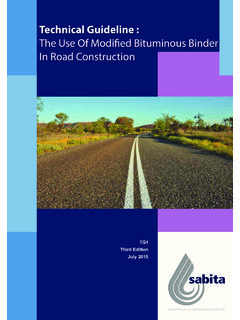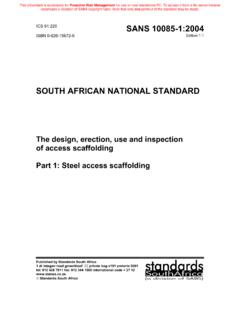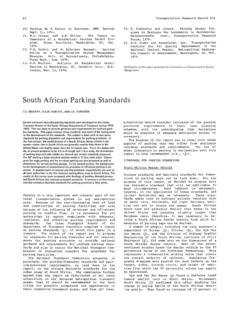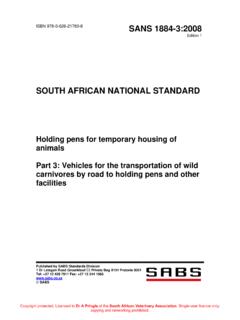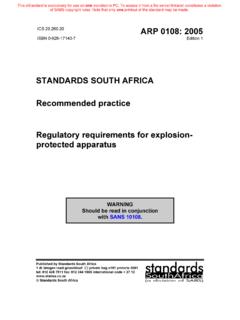Transcription of SOUTH AFRICAN NATIONAL STANDARD - Asphalt …
1 ISBN 978-0-626- SANS 3001-BSM2:201X Edition 1 SOUTH AFRICAN NATIONAL STANDARD Civil engineering test methods - Part BSM2: Laboratory mix design of bitumen stabilized material Published by SABS standards Division 1 Dr Lategan Road Groenkloof Private Bag X191 Pretoria 0001 Tel: +27 12 428 7911 Fax: +27 12 344 1568 SABS Table of changes Change No. Date Scope . Acknowledgement The SABS standards Division wishes to acknowledge the valuable assistance of the Committee of Transport Officials (COTO), the SOUTH AFRICAN NATIONAL Roads Agency, the SOUTH AFRICAN Bitumen Association (SABITA) and BSM Laboratories. Foreword This SOUTH AFRICAN STANDARD was approved by NATIONAL Committee SABS/TC 081/SC 08, Construction materials, products and test methods Bitumen and bituminous products, in accordance with procedures of SABS standards Division, in compliance with annex 3 of the WTO/TBT agreement.
2 This document was published in xxxx . SANS 3001 consists of various parts under the general title Civil engineering test methods. Parts BSM of the SANS 3001 series contain methods for testing bitumen stabilized materials. Annex A is normative and annex B and annex C are for information only. Introduction This method covers the laboratory mix design for bitumen stabilized material (BSM) used in the construction of road layer works using bitumen emulsion or foamed bitumen as the stabilizing agent. Apparatus dimensions that are critical to the outcome of the method or procedure are given with a tolerance. All other dimensions are nominal and should be considered fit for purpose. This STANDARD forms part of a set of methods used for mixture design and testing of bitumen stabilized material, and includes the following: a) determining the foaming characteristics of bitumen (see SANS 3001-BSM1); b) laboratory mix design of BSM (see SANS 3001-BSM2); c) vibratory hammer compaction of BSM (SANS 3001-BSM3); d) determining the indirect tensile strength of BSM (see 3001-BSM4); and e) determining the shear properties of BSM (see 3001-BSM5).
3 SANS 3001-BSM2:201X Edition 1 1 Contents Page Foreword Introduction Contents 1 Scope 2 Normative references 3 Definitions 4 Apparatus 5 Principles 6 Preparation of test sample General Test sample sizes Preliminary tests Sample proportioning 7 Mix design General Active filler selection Optimum bitumen stabilizer content Triaxial test specimens 8 Mixing General Bitumen emulsion stabilization Foamed bitumen stabilization 9 Calculations 10 Test report Annex A (normative) Determination of maximum dry density (MDD) and optimum fluid content (OFC) of a material treated with a bitumen emulsion Annex B (informative) Example of the sample proportioning procedure. Annex C (informative) Example of the calculation procedure This page is intentionally left blank SANS 3001-BSM2:201X Edition 1 3 Civil engineering test method Part BSM2: Laboratory mix design of bitumen stabilized material 1 Scope This part of SANS 3001 describes a mix design procedure for laboratory preparation, mixing, compacting, curing and testing of bitumen stabilized material using either foamed bitumen or bitumen emulsion.
4 2 Normative references The following referenced documents are indispensable for the application of this document. All normative documents are subject to revision and, since any reference to a normative document is deemed to be a reference to the latest edition of that document, parties to agreements based on this document are encouraged to take steps to ensure the use of the most recent editions of the normative documents indicated below. Information on currently valid NATIONAL and international standards can be obtained from standards SOUTH Africa. SANS 1649, Non-automatic self-indicating and semi-self-indicating weighing instruments. SANS 3001-GR1, Civil engineering test methods Part GR1: Wet preparation and particle size analysis.. SANS 3001-GR10, Civil engineering test methods Part GR2: Determination of the one-point liquid limit, plastic limit, plasticity index and linear shrinkage.
5 SANS 3001-GR20, Civil engineering test methods Part GR20: Determination of the moisture content by oven-drying. SANS 3001-GR30, Civil engineering test methods Part GR30: Determination of the maximum dry density and optimum moisture content. SANS 3001-BSM1, Civil engineering test methods Part BSM1: Determination of the foaming characteristics of bitumen. SANS 3001-BSM3, Civil engineering test methods Part BSM3: Making test specimens from bitumen stabilized material using vibratory hammer compaction. SANS 3001-BSM4, Civil engineering test methods Part BSM4: Determination of the indirect tensile strength of bitumen stabilized material. SANS 3001-BSM5, Civil engineering test methods Part BSM5: Determination of the shear properties of bitumen stabilized material (Triaxial test) TMH 5, Sampling methods for road construction materials. Pretoria. 3 Definitions bitumen stabilized material BSM gravel, crushed stone or reclaimed Asphalt or a blend thereof treated with bituminous binder foamed bitumen Vaporizing cold water in hot bitumen in create foam optimum fluid content OFC the percentage (by mass) of the combination of bitumen emulsion and water required to achieve the maximum dry density (MDD) of treated material raw untreated gravel crushed stone or reclaimed Asphalt 4 Apparatus Foamed bitumen laboratory unit, capable of producing foamed bitumen at a consistent rate of between 50 g/sec and 200 g/sec, equipped with a thermostatically controlled kettle of capacity 10 kg of bitumen, operating at a constant temperature 5 oC within a range of 160 oC and 190 oC.
6 The unit is to be equipped with an expansion chamber (similar to that used in full-scale production) into which water and hot bitumen is injected under pressure to create the foamed bitumen. The unit is to be capable of injecting compressed air and a set amount of water into the hot bitumen to produce a uniform foam. The amount of water added by mass is to be up to 5 % of the mass of the bitumen and added at a controlled amount 0,25 %. The unit shall be capable of producing a mass of foamed bitumen within 5 g of the prescribed amount, directly into a container or laboratory mixer. The unit is coupled directly to the pug mill mixer and is to inject the foamed bitumen directly into the running mixer uniformly across the full length of the mixer (between the two paddle shafts) by means of a fan jet fitted to the discharge end of the expansion chamber. Pug mill mixer, of capacity 30 kg, with twin shafts and variable rotation speed control, graduated from minimum to a maximum rotation speed of 144 rpm.
7 NOTE A Wirtgen WLB10S and WLM30 are examples of suitable foamed bitumen and pug mill units available commercially. This information is given for the convenience of users of this STANDARD and does not constitute an endorsement by TC 81 SC 04 of this product. Steel tamper or small laboratory crusher. Electronic balances, fine measurement type complying with SANS 1649 one with a capacity of 15 kg reading to 5 g and one with a capacity of 2 kg reading to 0,1 g. Suitable basin, of about 500 mm diameter for mixing. Containers, airtight of capacity: a) 20 L for stabilized material; and b) 1 L for moisture content determination. Sieves, that comply with SANS 3310-2, that comprise a 450 mm diameter sieve set with pan, that consists of sieves with nominal aperture sizes: 20 mm, 14 mm and 5 mm. SANS 3001-BSM2:201X Edition 1 5 Litmus paper.
8 5 Principles The mix design procedure requires step-wise and iterative ITS testing to select the most effective active filler and the optimum amount of stabilizing agent. At various stages the mix designer has to make selections based on the outcome of ITS tests, so that the next step can be carried out. The procedure is outlined in table 1. Table 1 Mix design procedure 1 2 3 Stage Step Action by Description of action required Preliminary 1 Laboratory Carry out preliminary tests to determine the moisture content, grading and plasticity of the field sample. 2 Designer Input Approve material or specify material and blending proportions to adjust grading and plasticity. 3 Designer Input Select type of stabilizing agent foamed bitumen or bitumen emulsion. 4 Laboratory Proportion the material and reduce to minus 20 mm maximum size.
9 5 Laboratory Test the stabilizing agent to determine its properties. Active filler 6 Laboratory Mix specimen samples with stabilizing agent and raw, lime-treated and cement-treated material. 7 Laboratory Compact specimens, cure and ITS test to determine the wet and dry values. 8 Designer Input Select type and amount of active filler. Stabilizer content 9 Laboratory Mix specimens samples with active filler selected in step 8 at 3 stabilizing agent contents. 10 Laboratory Compact specimens, cure and ITS test to determine the wet and dry values. 11 Designer Input Select optimum stabilizing agent content. Triaxial test 12 Laboratory Mix specimens samples with active filler selected in step 8 and stabilizing agent content selected in step 11. 13 Laboratory Compact specimens, cure and Triaxial test to determine the wet and dry shear properties. Outcome 14 Laboratory Report ITS and Triaxial results for the design mix.
10 6 Preparation of samples and preliminary testing General During the preparation procedure input from the BSM mix designer is required to specify approval or modification of the raw material (by blending) and the type of stabilizing agent to be used. The preparation procedure is dependent on whether bitumen emulsion or foamed bitumen is to be used as the bituminous stabilizing agent. The paragraphs dealing with the other stabilizing agent should be ignored and the specified design inputs should be clearly indicated on the test report. Sample the field material to be stabilized in accordance with TMH5. A large sample of at least 400 kg for each mix design is recommended. This quantity enables preliminary testing to be carried out and for fractions of material to be discarded during the preparation stage. Test samples sizes The size of the test samples will depend on the extent of the testing programme envisaged.
